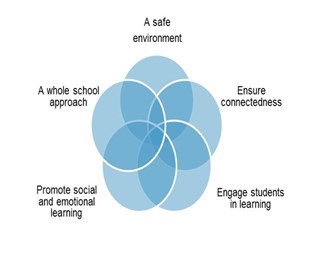Several keynote speakers including Dr Kelly Burgoyne (formerly of Downs Ed International) and Dr Rhonda Faragher shared evidence-based research and practical classroom applications to improve student outcomes in the areas of numeracy and literacy.
Aiming to “equip attendees with a toolkit of practical strategies, information and resources to best support students in various educational contexts,” the session highlighted the importance of the wellbeing for students within a school environment and offered the following elements in supporting the student’s needs. These elements are all interconnected and should be viewed as interdependent aspects of wellbeing:


Key Points to Consider - Programming
- When designing your program for a student with DS, it is advised to adjust your current program rather than write a different or alternate program, adjusting the program to the student’s strengths.
- Record adjustments in your program and annotate within the program. Adjust what you are already delivering to the remainder of the class.
Ask yourself the following questions when looking at adjusting the program:
- What is the goal for the lesson?
- How can we adjust the worksheet or activity to suit?
- Would technology help?
- Does the student need material presented differently?
- Should student present their work differently?
- Will student be assessed the same way?
- Will student need different assessments?
When delivering the content consider the following:
- Determine key concept the student must learn.
- Break tasks in to smaller components – Task Analysis
- Provide opportunities to practice new skills and concept
- Alter the amount to time given to for task completion
- Change level of difficulty of task
- Allow student to record lesson – video, audio
- Provide a visual of key concepts for the student to follow or utilise as a cue
- Adjust workload- reduce assignments or an alternate assignment.
- Use scaffolds to support task completion
- Visuals with oral presentation
- Visual checklists
- Alert student when important information is being introduced by stating their name
- Consider the use of Assistive Technology
- Calendar or visual planning.
- Universal Design for Learning (UDL) - plan ahead of time. Think ahead and routinely plan strategies and include as many adjustments as possible from the beginning.
- Seek guidance about specific learning issues. Resources available from DSNSW, Nationally and Internationally.
- Explicitly plan adjustments - give clear direction to Learning Support Assistant's (LSA). Inform the LSA what you explicitly like them to do - this is really important. This is not about getting the task finished but more about the process for the student and ensuring the process is mastered. Work out the purpose rather than getting the work finished.
Question: How do we teach our students with DS?
Answer: Teach like media ads/ commercials, use their tricks:
- Capture attention - a “little bit, often” rule
- Prime time - time of learning.
- Slogans for big ideas (friends of ten, rainbow facts)
- Use the visual
- The element of surprise (anticipate, make them wonder what's coming)
- Break the learning into smaller steps
- Ads teach, don't test. Present materials and not test them.
For further information on teaching students with down syndrome, please visit Down Syndrome Australia or KidsHealth.
